Ok, I still have a ways to go before it's all done, but I've moved all of this content over now and I want to start posting again. So, from now on, everything will be at:
So wend thee thither.
You had me at ]❚
Ok, I still have a ways to go before it's all done, but I've moved all of this content over now and I want to start posting again. So, from now on, everything will be at:
So wend thee thither.
For anyone who happens to read this, I'm phasing this Blogger site out in favor of an externally-hosted WordPress site. I'm still moving things over there and setting it up, it'll probably be a few days yet before I post the address. But the stuff from here has been transferred already, so comments will just wind up going into the void.
So, I got an Apple ///, and as reported earlier, it started up to the "RETRY" prompt successfully, but when I put any disks in the drive, it made a godawful racket. There was clearly something not quite right about the internal drive.
As it happens, though, I just recently acquired a second, external drive for the Apple ///. A fairly rare creature called the Disk ///.
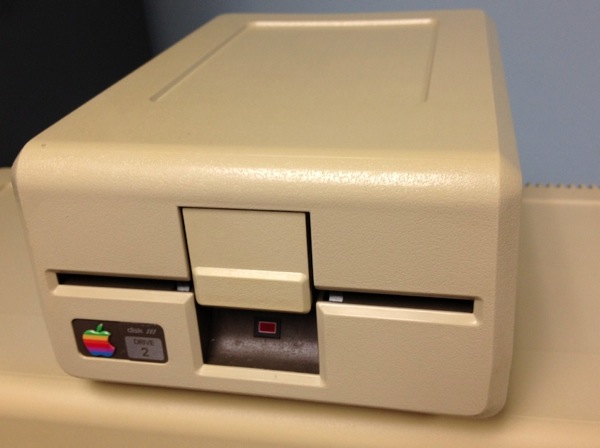
It took me a while not to just see this as ugly, but by now I kind of like it.
Though I can't say that I'm not a little bit annoyed that the previous owner decided to doodle around the Apple logo on the drive with a ballpoint pen. I did try to clean it up, but it still looks like this.
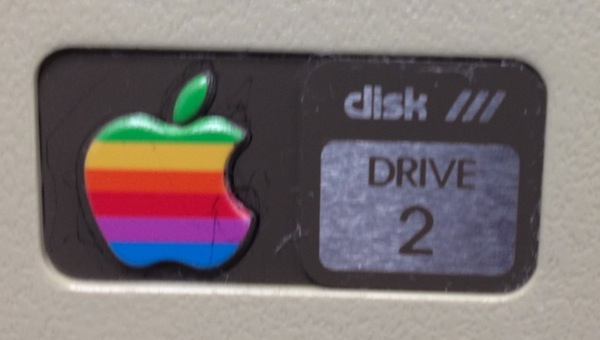
I completely disassembled the drive in order to clean it up, which I'll detail here, although it turned out that it really was already pretty clean.
The case comes off pretty easily, four screws on the bottom...
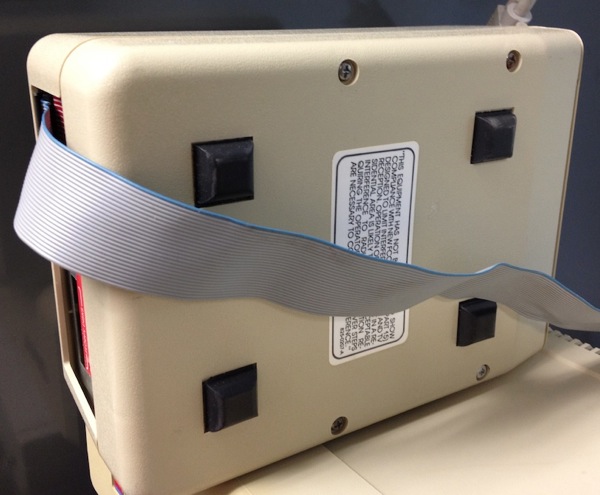
...and then one screw in the back...
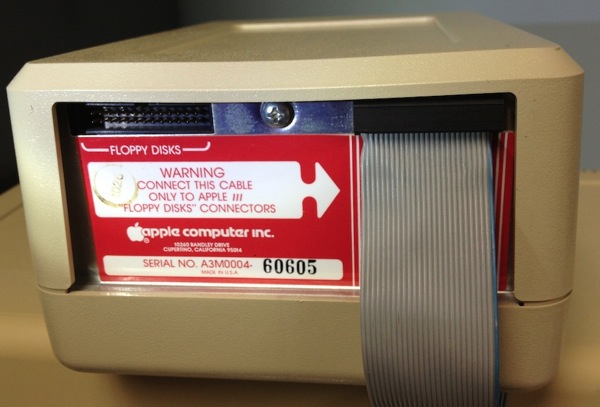
...and plastic shell comes off.

Oh, by the way, I also got a 5MB ProFile drive, speaking of things the case parts are sitting on.
Oh, and, by the way, that ProFile drive powers on.
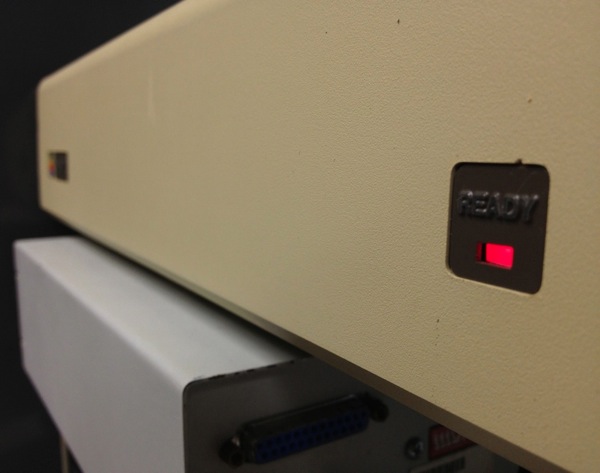
However, in order to use it in the Apple ///, I need to have a controller card. I could use it straight away on the Lisa without any extra hardware, and maybe I will, though I expect that (since I got the Disk /// and the ProFile drive in the same place) the ProFile was being used on an Apple /// most recently, and so might actually still be bootable. So, I'm postponing my decision about that for the moment, and just stacking the ProFile up with the Apple /// as it was designed to be placed, not connected to anything.
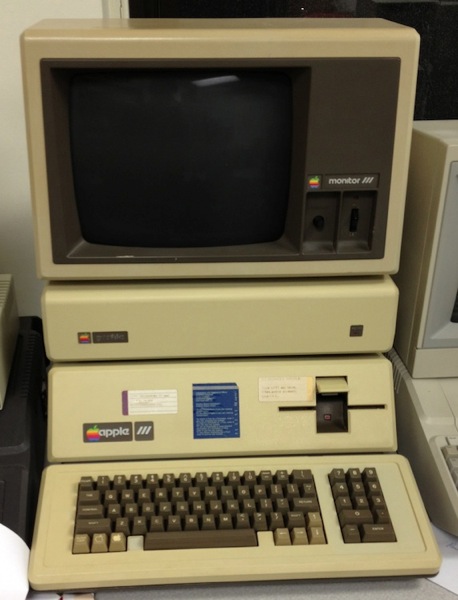
Anyway, back to the story. So, once the Disk /// case is off, there's an aluminum shield over the drive that is held in by four more screws. I took it off before I took this picture, though it's still connected to the ribbon cable and partially visible in the back.
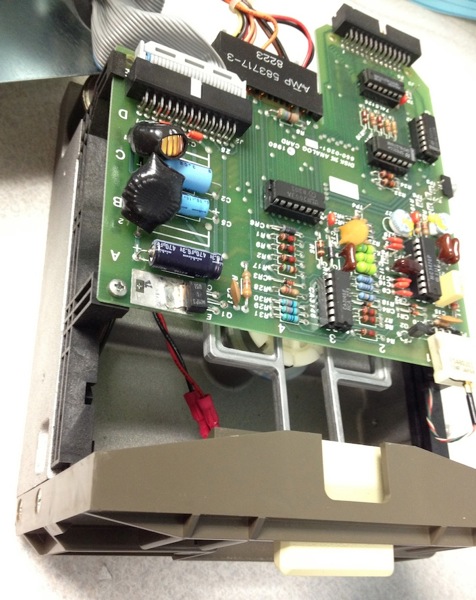
The analog board is held in by two screws and some plastic clips. Once the screws are removed, and the at least one of the three things plugged into the board are removed, then the analog board slides out toward the back until it is free from the clips.
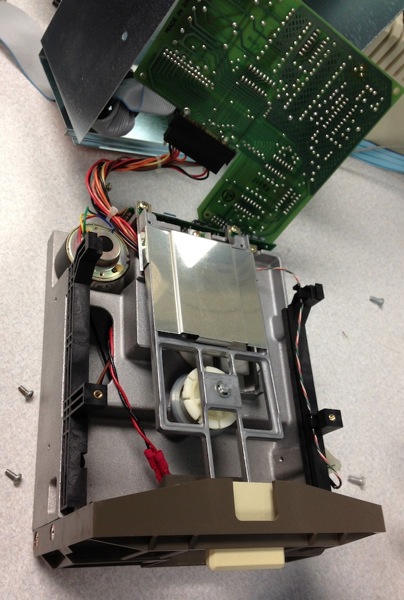
Below the analog board, there is another metal shield over the drive head mechanism, which is just clipped on. Here's the drive head below the shield, I've lifted up the pressure pad on top. It was—amazingly—clean, but I cleaned it with alcohol anyway, for good measure.
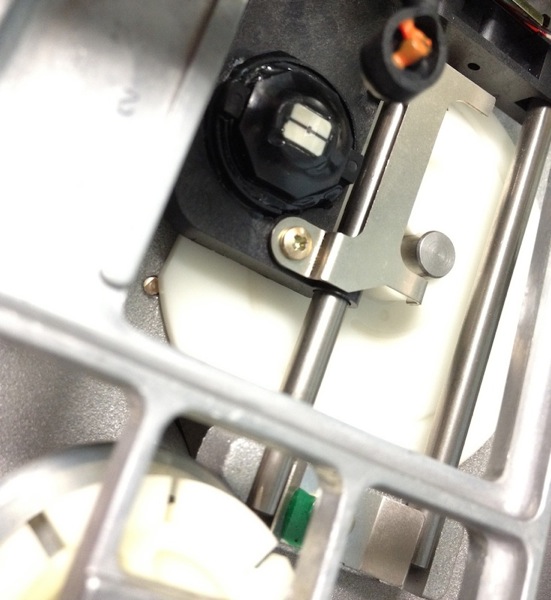
Now, with the drive all clean, I had the other drive—the internal drive—to confront. Since the external drive looked so nice, I decided that the best course of action would be to swap them. To put the mechanism from the external drive into the machine as the internal drive and put the internal drive's mechanism into the external case. At the very least, it would be easier to work with it if it needed repair.
It turns out that this is easy, but not simple. The internal and external drives have the same basic mechanism, but they have different front panels. The internal drive has a drive door that rests at an angle, flush with the body of the machine, while the external drive has a drive door that closes to vertical. So, I needed to also swap the front panels as well.
Here is the internal drive in place, before any of the work began.
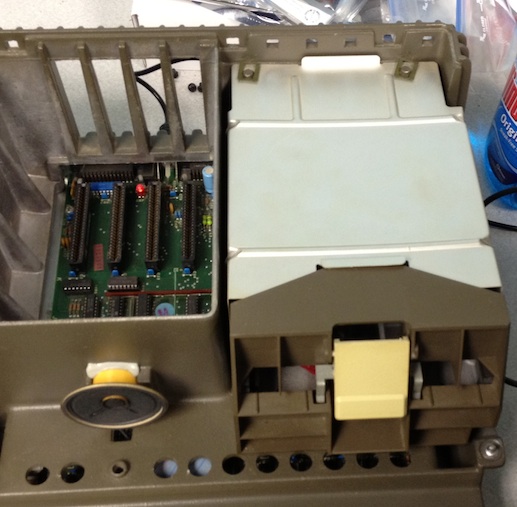
To get it out, a couple of clips need to be removed, which hold in the aluminum shielding around the drive, and then two screws at the front need to be removed. Once it's out, and the cable is removed from the analog board, you can see where the screws were that held it in, as well as a small metal widget in the back that kind of holds it in place.
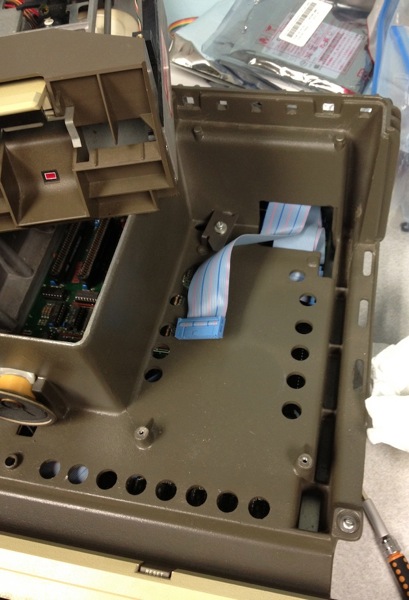
Here's a better look at the drive itself when out, and the analog board removed. Note the quite different front panel.
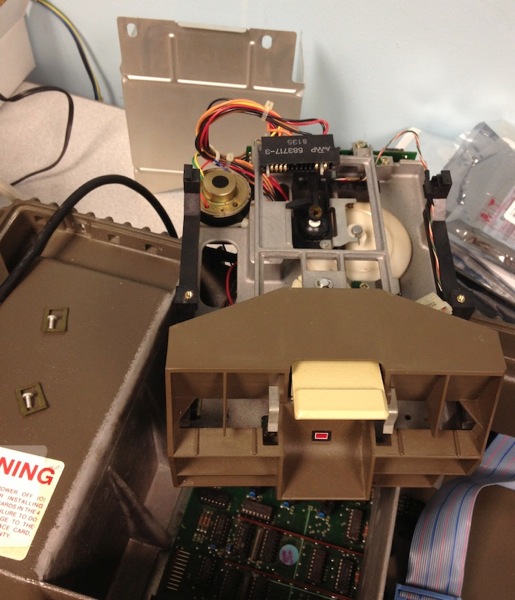
I performed pretty much the same procedure on this one, cleaning the internals and drive head off with alcohol, though this was much less clean inside than the external drive had been.
Then I addressed the replacement of the front panels. Apart from a little bit of trickery getting the plastic pieces associated with the drive door lined up in their grooves, this wasn't too tough. The hardest part was dealing with the drive busy lights, which are anchored in the panels. After a bit of investigation and wiggling of pieces, I determined that they are held in by a two-piece black outer case that pretty much slides apart, held together by friction. When the back of the case is off, the LED and the front of the case are free to move. The front of the case clips on to the LED with very small plastic clips, but gently loosening the clips while pushing the LED out through the back with plastic pen cap was sufficient to get them apart. I don't have a photo of the disassembled LED, but just imagine it. Like in a text adventure.
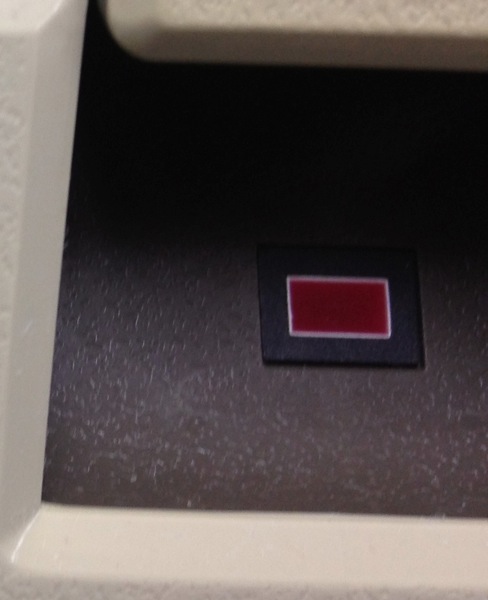
In order to get the front panel off, I had to break the seal on the screws that held it on. I think I may have voided the warranty.

After that, putting the internal front panels on the ex-external drive was pretty straightforward. No additional photos of that.
Then I turned my attention to the now-external drive, to put the external front panel on it. This was the drive that wasn't working properly. As I was dealing with it, I noticed that the whatever-it-is-called belted to the drive motor (that actually spins the disk when it's in the drive, and has the checkerboard calibration marks on it) was slipping out as I held the drive. That's not something the other drive had done.
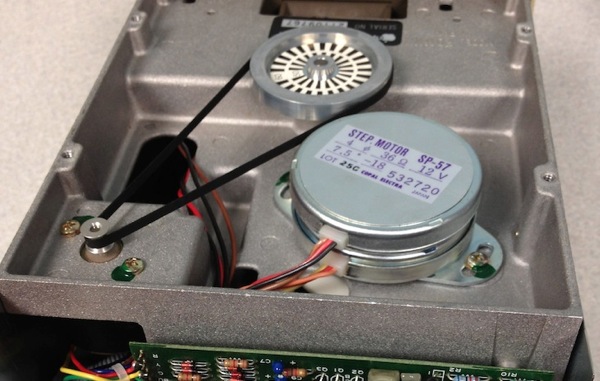
I discovered that, on this drive, the ex-internal one, the metal thing that grabs the disk hub from underneath was completely loose, barely connected at all, and came off as I was investigating it. I don't have a photo of it when it was off, but it's this thing, shown here in its rightful place in the ex-external drive.
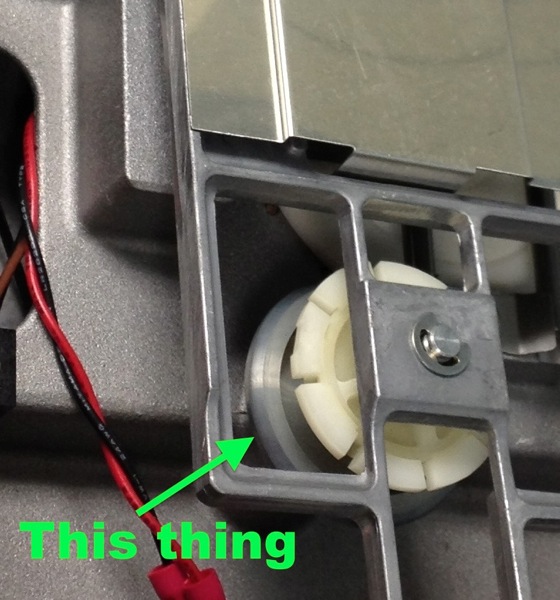
That thing, though, seems to just be held on by friction. I was able to push it back on and it seemed pretty secure. So probably it had come loose during shipping, or some previous jostling the machine had been subjected to. It did explain fairly well the noisiness of the drive when spinning, though, if it wasn't gripping properly to the drive motor. So, it was a pretty easy repair in the end.
Everything reassembled, I decided to give it a whirl. I made a couple of Apple /// disks using ADTpro on a //c that was nearby, including a demo disk and a diagnostic disk. I put in the demo disk, and, lo:
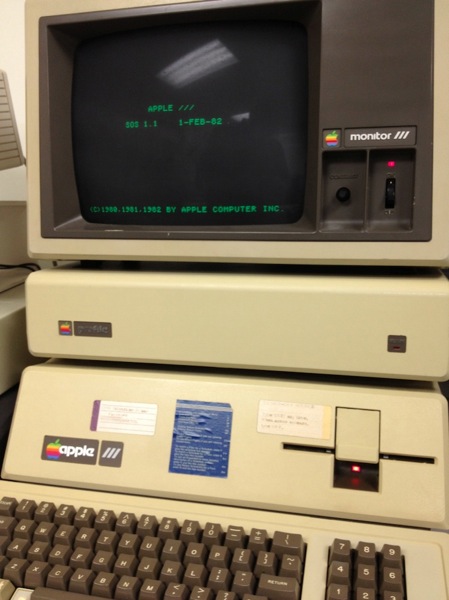
Though then I got this:
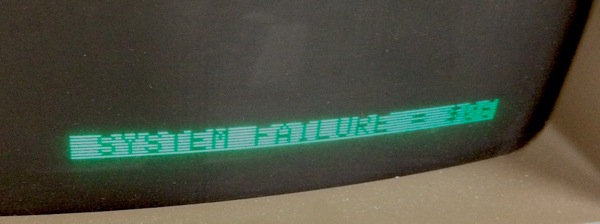
Still not sure what's up with that. I'll worry about that later. [Later: It's a 6502 stack overflow error, which Apple says is a common result when booting a copy of certain copy-protected disks. And this was no original. So, I'm not too worried about this error, I'll just boot different disks. I'm also clearly not the only person having this issue, since Google Suggest had my target ("apple iii system failure $06") in view by the time I had finished typing "apple iii sy".] Undaunted, I put in the diagnostic disk, et voilà:

I ran a bunch of the tests, though it takes a bit of practice to know what it is expecting. The video diagnostics seem to be taking a particularly somber view of their duties on this occasion, knowing that if they failed, the whole world would sink into the abyss of a new dark age made more sinister, and perhaps more protracted, by the lights of perverted science.
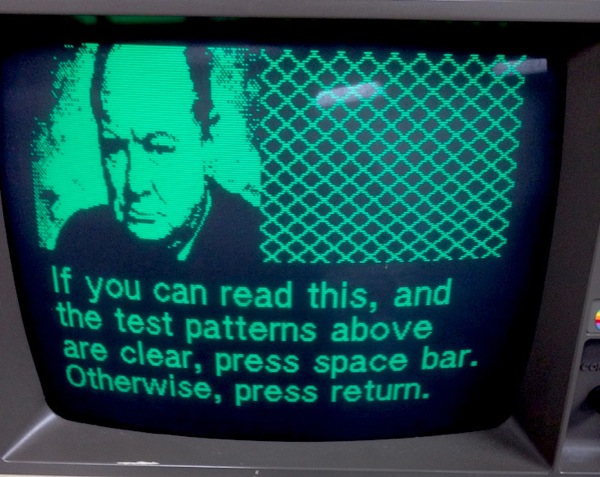
And as far as I can tell, there were no tests that it failed. There might have been a problem with one of the modes in the video test but most worked fine, the RAM and ROM and keyboard and sound passed, and the disk test I think came out ok as well. So, indeed, the diagnostics came though. Surely, if this Apple /// lasts for another 30 years, men will still say, this was their finest hour.

There is a new "oldest Apple ][+ I have ever seen" (or at least, seen a label for). Prior to this, it was A2S2-11547. The new smallest serial number (on an Apple ][+, A2S2-) that I've seen is A2S2-10087:

Board date: second week of October 1979.
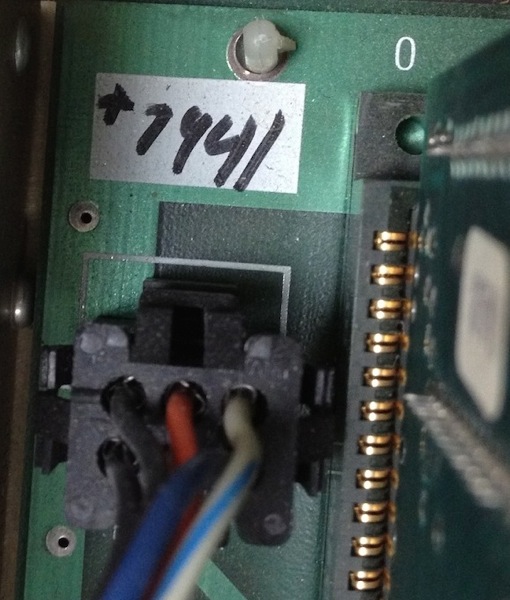
And: It's in my office.
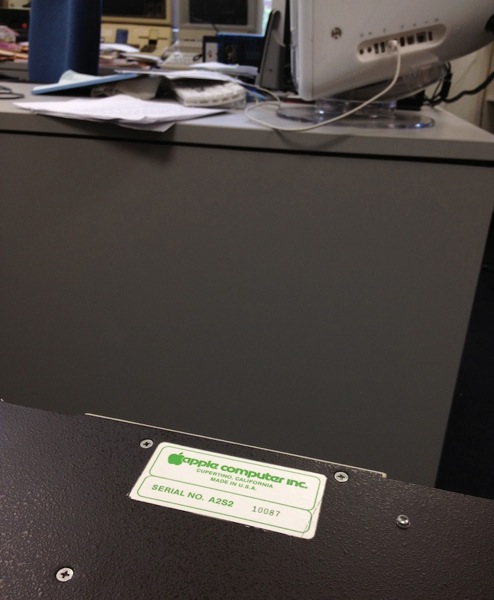
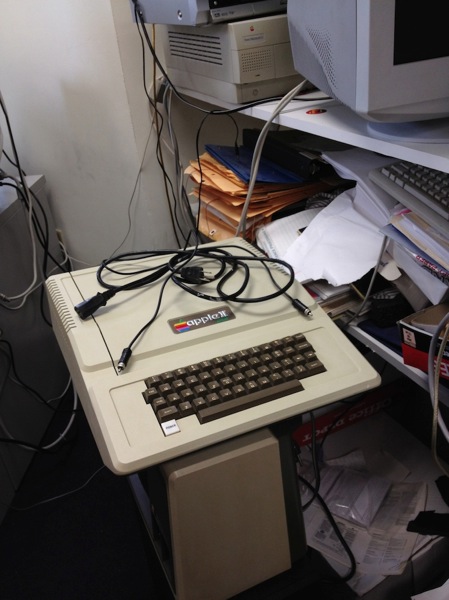
Today I got another label:
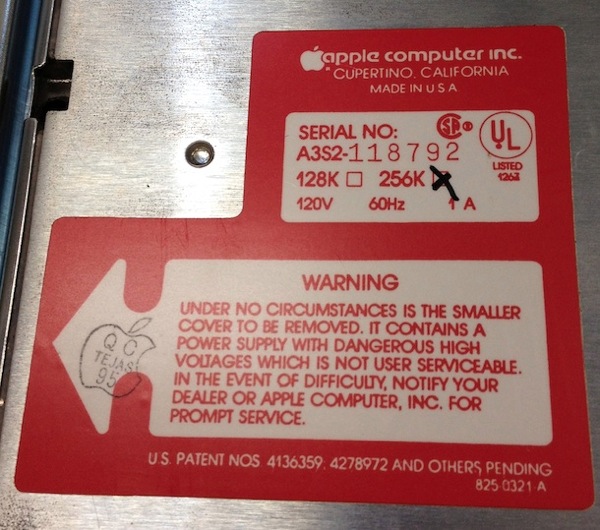
It was attached to this:
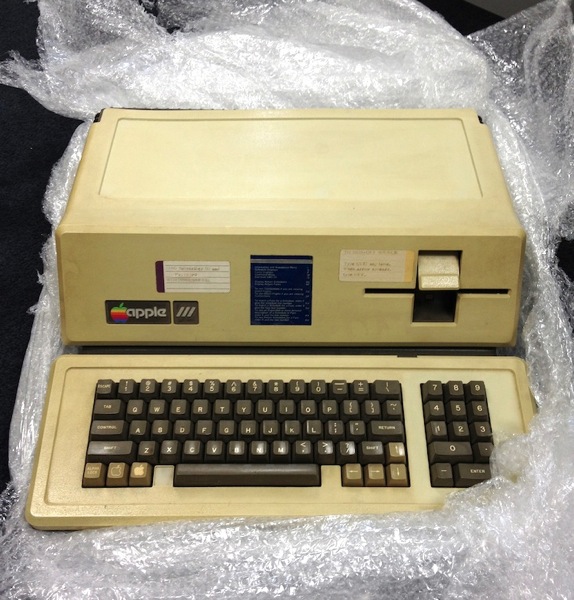
Yep.
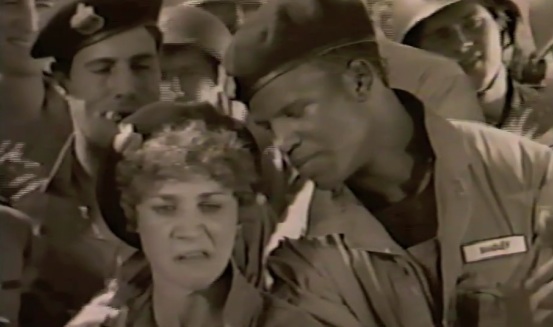
One more thing. Let us never forget the glorious victories of the past: World War I, World War II, ][+, //e, and //c.
—What about ///?
—We don't talk about ///.
(at 3:22 in the full version of "1944")
The Apple /// was not exactly a great success—there were various problems with it, some real, some legend, but it is generally considered a flop. One of the things that was known to be kind of a problem with them is that their chips sometimes came unseated (whether due to being loosely inserted initially or due to "walking" out as a result of heat cycling seems to be debated), but before I started trying to do anything with it, I wanted to be sure that the chips were seated. And I wanted to give it a full cleaning. Also, the seller indicated that the machine started up with just an error code. Since the seller also told me that (a) the code it presented did not indicate any RAM problems, and (b) the keyboard lamp did not come on, I was optimistic that all it really needed was a new keyboard lamp. The Apple /// has the kind of strange property that if the lamp under the "ON" light burns out, the machine won't start. In discussions on IRC, this was hypothesized to be in order to make sure that people could tell the machine was on, so there were no attempts to add or remove peripheral cards while the machine was powered up. However, at least in mine there is in fact also an LED on the motherboard that lights up when the power is on, so that doesn't seem to be a complete justification for this design decision. Nevertheless, the fact remains: if the light burns out, the machine is rendered inoperable.
Anticipating this, I ordered two replacement bulbs for the keyboard, which, as luck would have it, also arrived today. So, I disassembled the machine and cleaned it up, and replaced the bulb. The old bulb's filament was clearly severed, so things were on the right track.
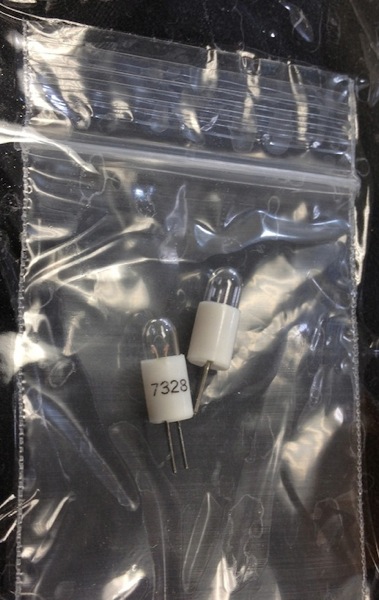
Et voilà.
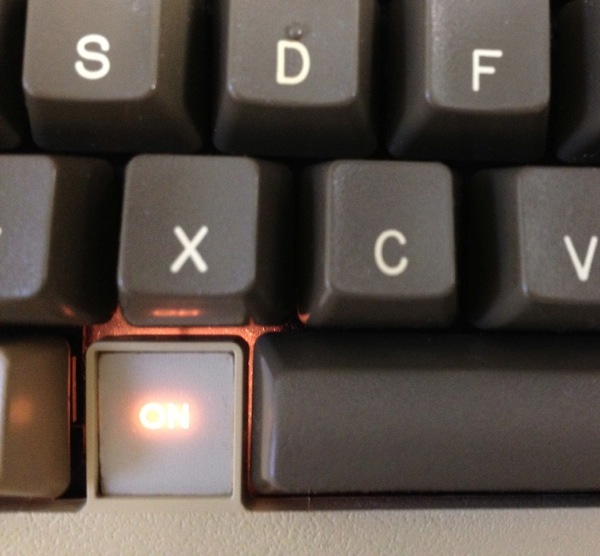
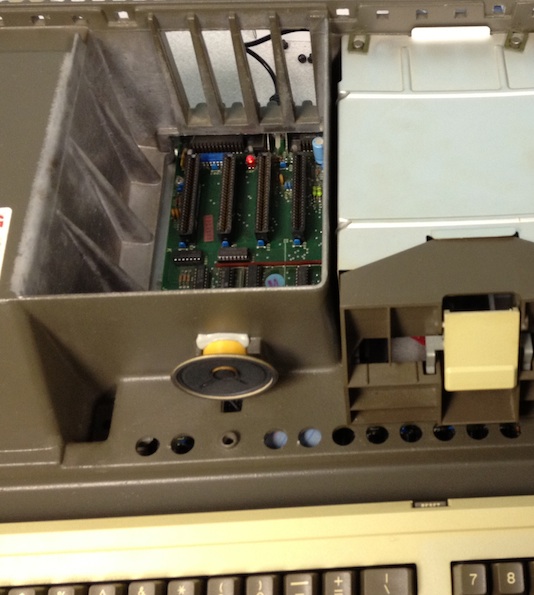
Best of all, no error codes on the screen. As it happens, I never got to see the error codes in the first place, because I didn't want to power it up before I'd checked to be sure the chips were seated. But now, what I got was exactly what I should have gotten under the circumstances (with no disk inserted).
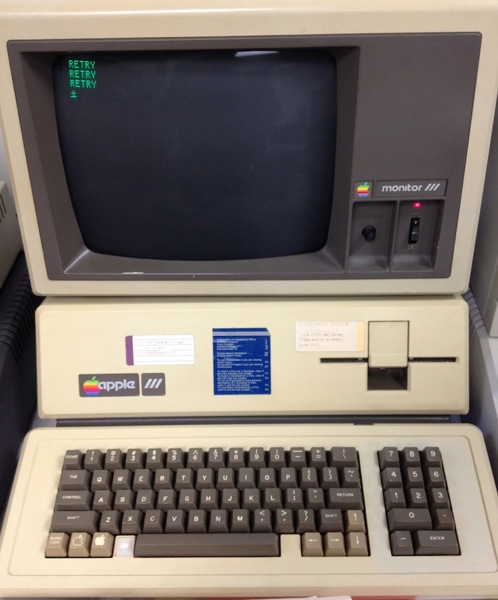
I did try putting in a disk, though I didn't think it would work. I think the disk drive needs cleaning, it was pretty noisy. But I'm well on my way. Next stop will probably be to try to boot it with ADTpro, and then we'll see where it goes from there.
After going through a pile of label images that I've been collecting in the recent past, it seems like I can start to make some generalizations. They might be right. [Warning: a lot of these pictures have just been lifted from eBay auctions, most of them aren't mine.] [Warning 2: I may occasionally add more labels to this post as I see them.]
The oldest Apple ][ label I've seen (or at least have a picture of handy) is in this style, A2S1-4625:
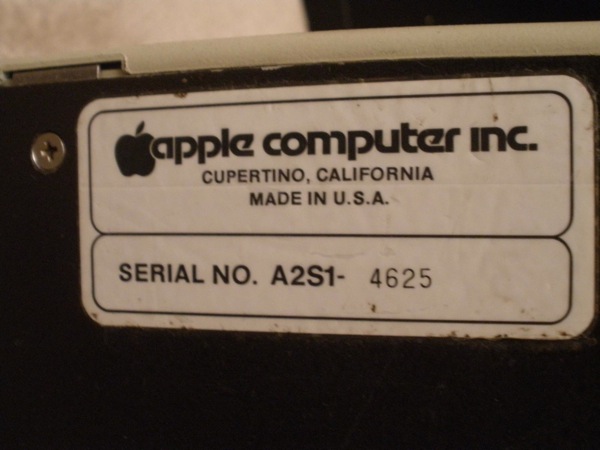
That one enclosed a motherboard with date code 8040, which I have no reason to disbelieve based on the chip dates, which are all 1978-1980 that I could see. Which pretty much means that the motherboard was replaced along the way.
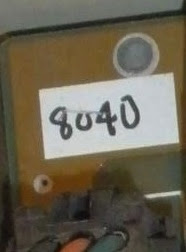
Here are a couple more. A2S1-8576, A2S1-16122 (7903, sadly the ][ lid was replaced by a ][+ lid during an upgrade), A2S1-16784 (8068?, replaced, appears to be a ][+ board, rev 4), A2S1-27105 (7919), A2S1-39587 (but motherboard was replaced with a ][+ board):
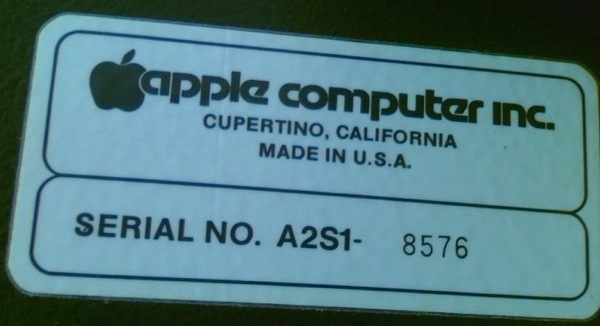
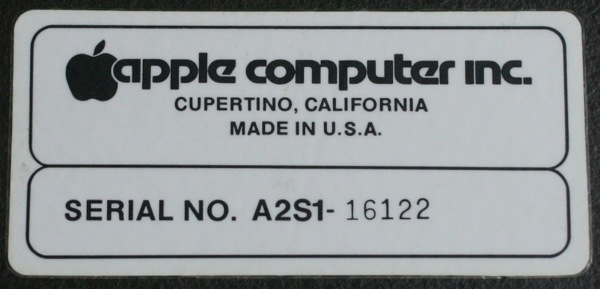
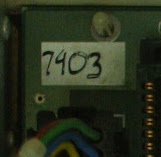
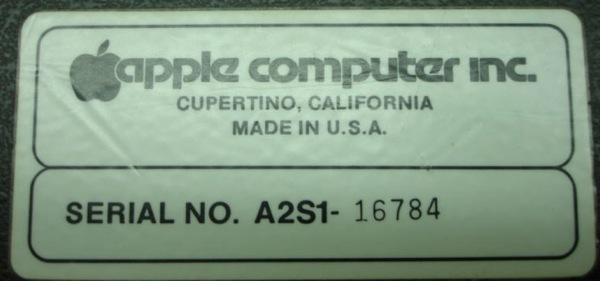
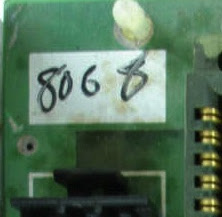
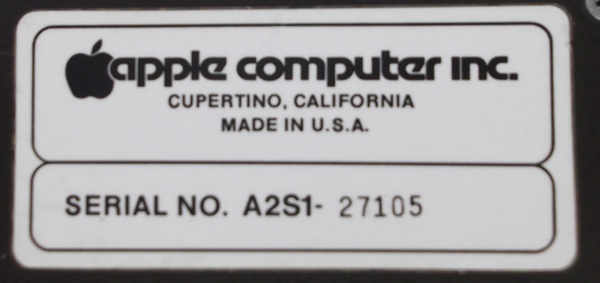
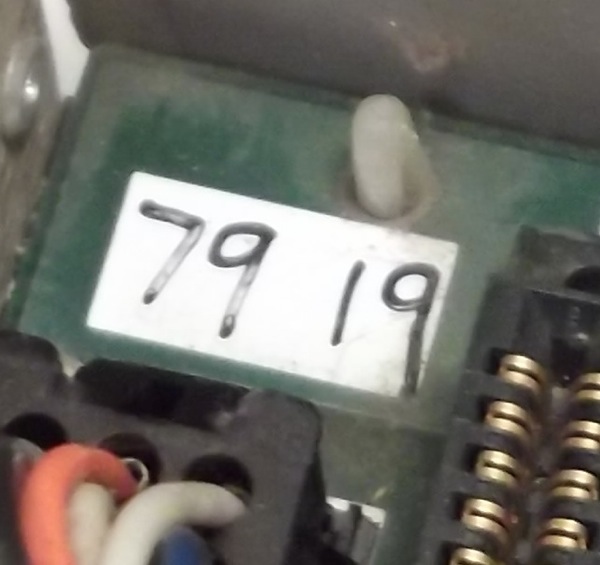

The next set of Apple ][ labels I've seen are the newer squarer ones, in red. Here the images I have jump to the 60000s, and perhaps there was a serial number "jump" somewhere here. But here are the red ones, A2S1-61786, A2S1-64313, A2S1-66077. I don't have board dates for any of those. And in any event, there's at least some cause for caution in trusting that the board that's in there is the one it shipped with. Note that A2S1-4625 had 8040 in it, while A2S1-27105 had 7919 in it. The 7919 board matches the timeline better, it's basically certain that the 8040 was a replacement. However, I've also seen 8022 and 8025 with all the hallmarks of an Apple ][ board (chip under slot 6, 16K select, flanged slots).
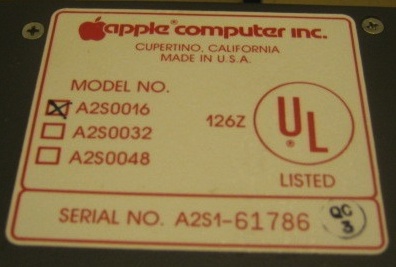
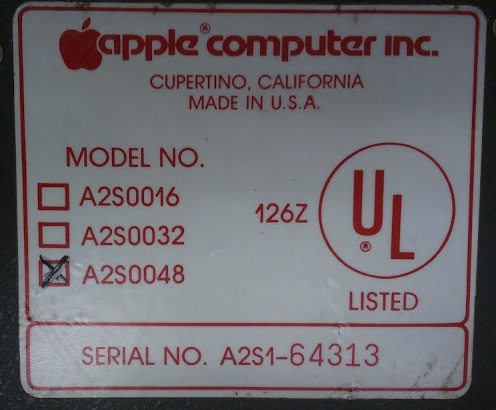
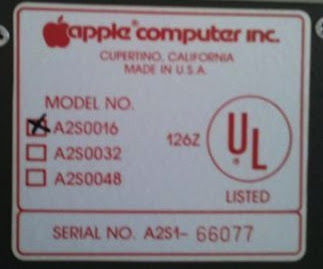
Moving on to Apple ][+, the serial numbers begin to start with A2S2, but the earliest ones are still in the earlier sticker style. The oldest one I've got an image of (update: now "second oldest one I've got an image of," see A2S2-10087) is A2S2-11547, board date 7945 (along with what I originally took to be an "x", but which I now believe to be a "plus", signifying that this motherboard was built as an Apple ][+ rather than as an Apple ][, since it could have been either at the point of assembly). This board also has what I called above having "all of the hallmarks of an Apple ][ board", which leads me to suspect that it was an Apple ][+ fashioned from an Apple ][ (by adding the Autostart ROM chip), though on the other hand I think all of these characteristics can be present on the earliest of the (actual) ][+ motherboards.
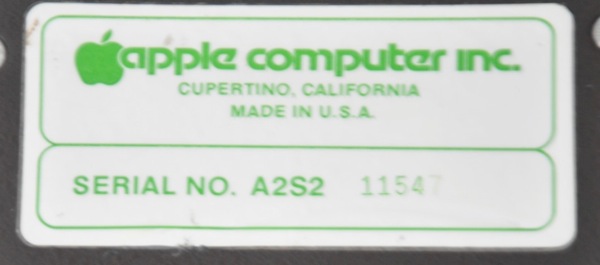
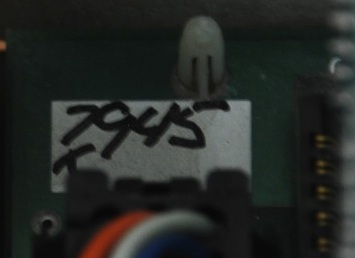
Next comes A2S2-18606, same style. Board date hard to make out, but in the little bits I've blown up 4x, it appears to be 79xx. And same deal on this one, it looks like an Apple ][ board that was turned into a ][+ by adding the chip.
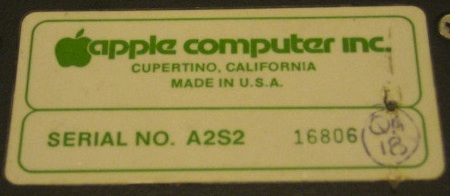
|
|
|
|
|
Then a big jump, new label style, lowest one I have encountered is A2S2-65001, board date 8006. But still the old hallmarks of an Apple ][ board.
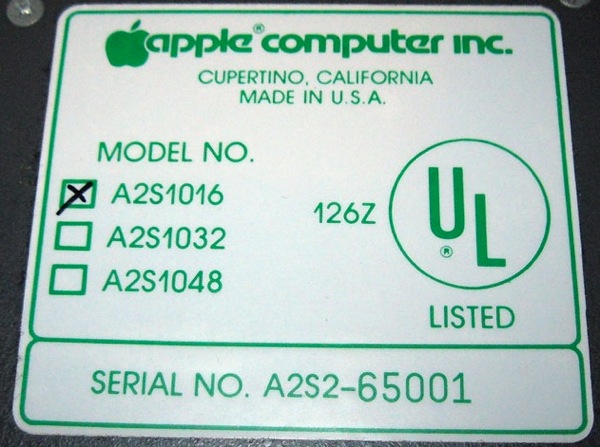
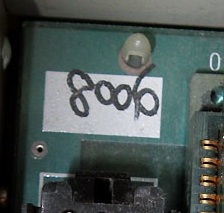
I have various examples of this label style, all of these others seem to have newer revision boards where I can tell, with "N" pattern under slot 6, non-flanged slots, no 16K select chips, RFI attachment screws. A2S2-66915, A2S2-93277, A2S2-109180, A2S2-115091, A2S2-120955 (board replaced, had an RFI shield, and dated 8519, also oddly enough had a ][-non-plus lid), A2S2-122481, A2S2-149143 (8102), A2S2-161227 (8110), A2S2-164919, A2S2-174147, A2S2-179992, A2S2-359691, A2S2-362495 (0182), A2S2-403239.
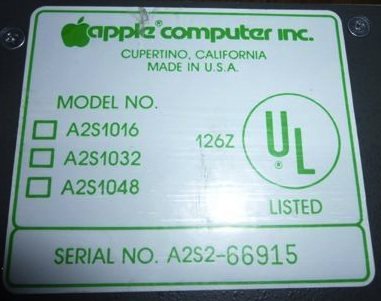
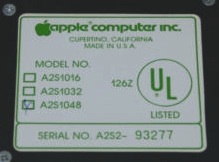

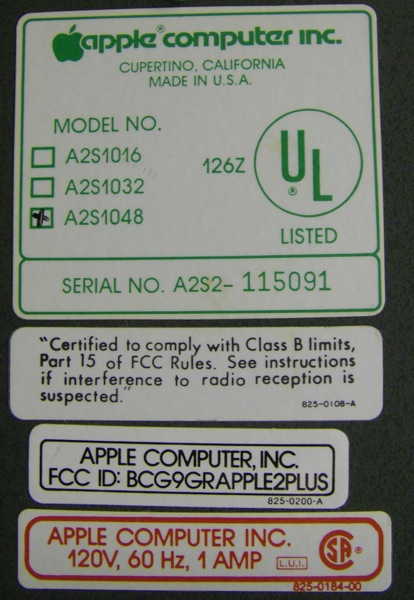
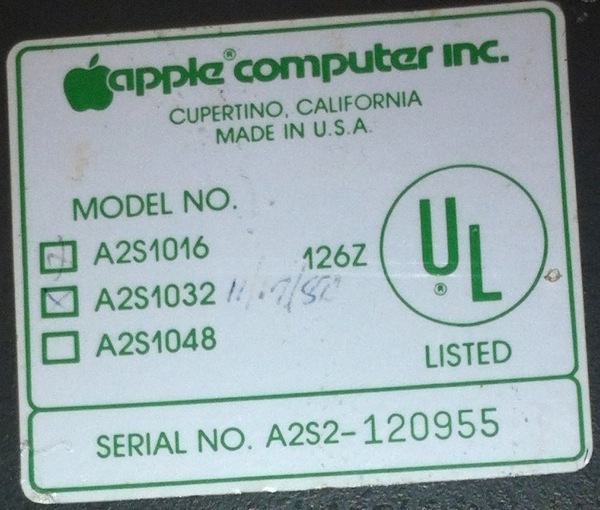
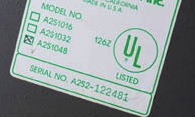
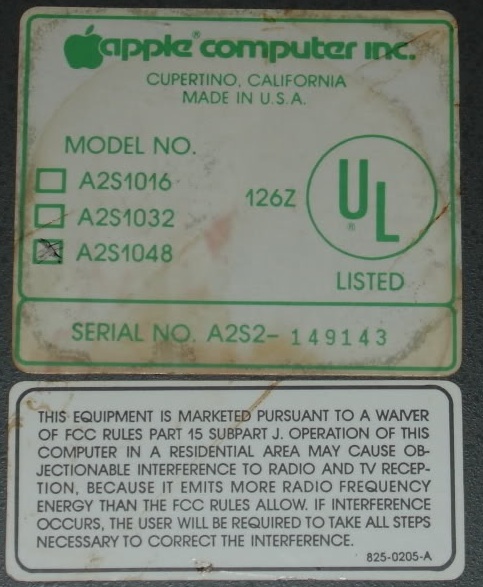
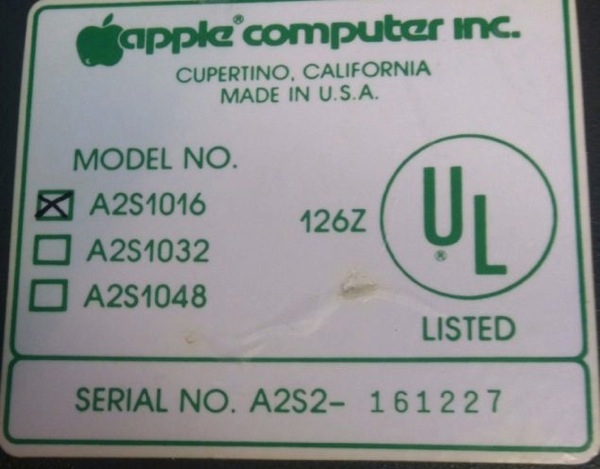
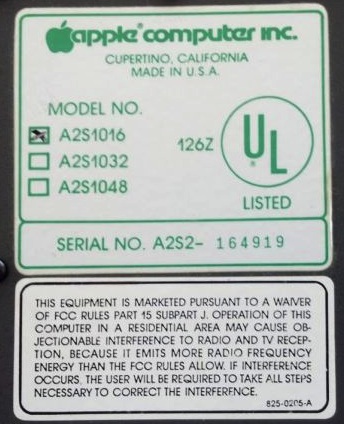
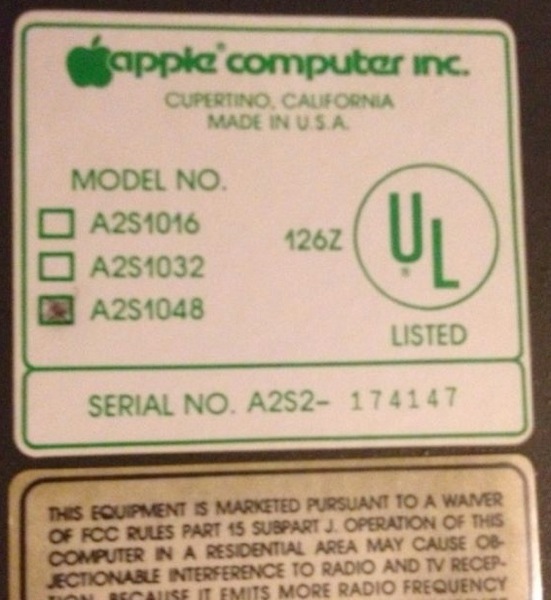
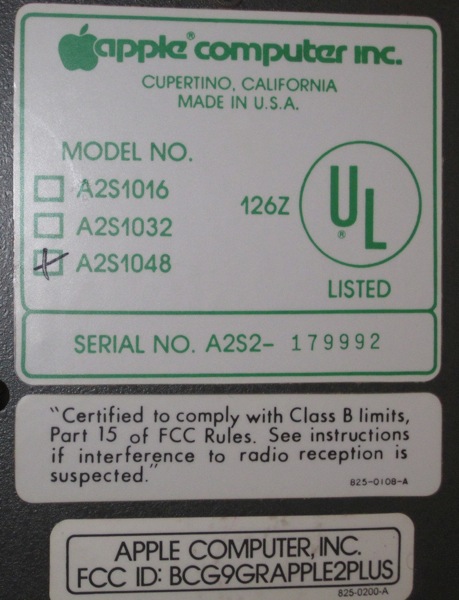
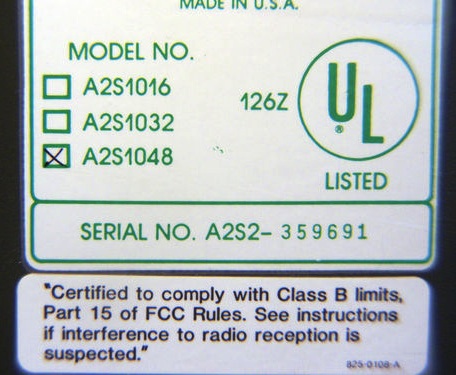
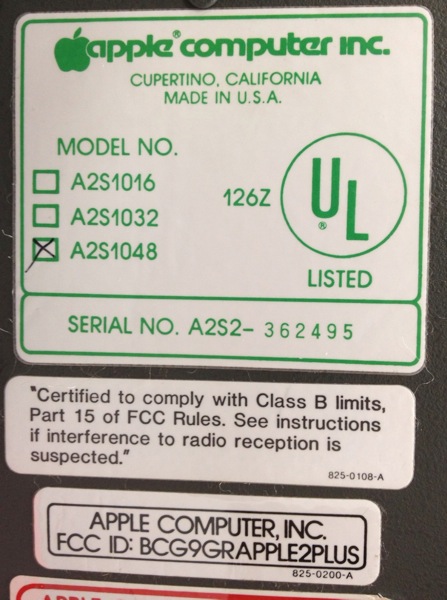
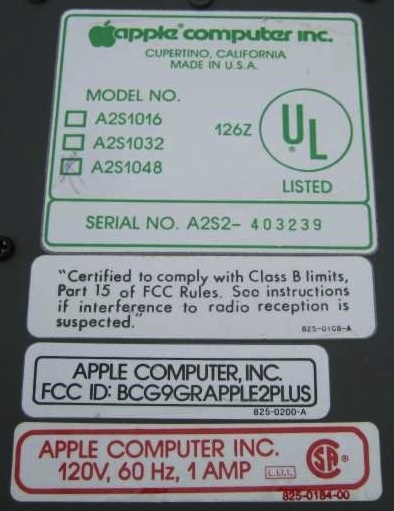
The penultimate one there is interesting in that the motherboard inside it had a different date code style, listed as 0182, and stamped on rather than written on by hand (I don't have any evidence one way or another for the last one above). Somewhere between 161227 and 362495 this practice must have changed. All dates I've seen before this are in YRWK order (or at least YRxx for some xx, there is a single example I've seen (shown above among the Apple ][ labels, where the board has a date code that appears to be 8068, which is clearly not YRWK unless it is a sloppily written 8008, which it could possibly be). Perhaps it was simply just the practice in 1982 and beyond, since I have a couple of (poor) examples above of 81xx dates as well.
|
|
|
|
|
|
At this point, the labels switched style again, to the newer, busier one, with a dot matrix serial number. A2S2-448225, A2S2-472596 (3782), A2S2-512896, A2S2-544771, A2S2-546018 (4782), and the highest two serial numbers I have actually seen, A2S2-569185 and A2S2-588496 (on empty cases).
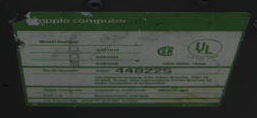
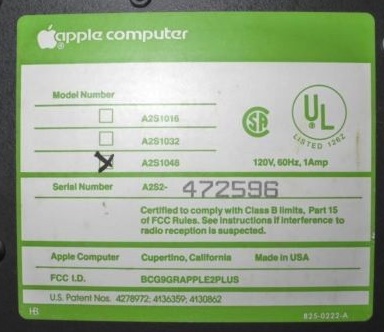
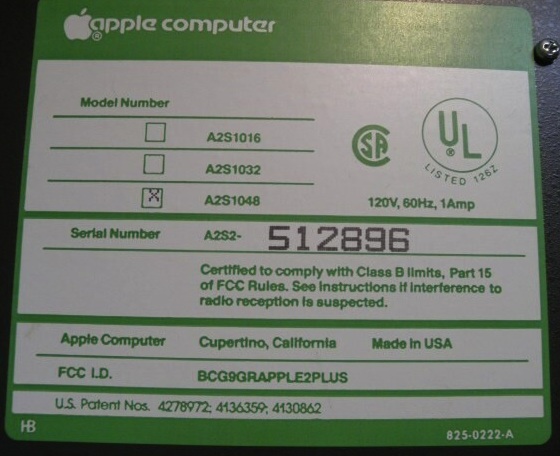

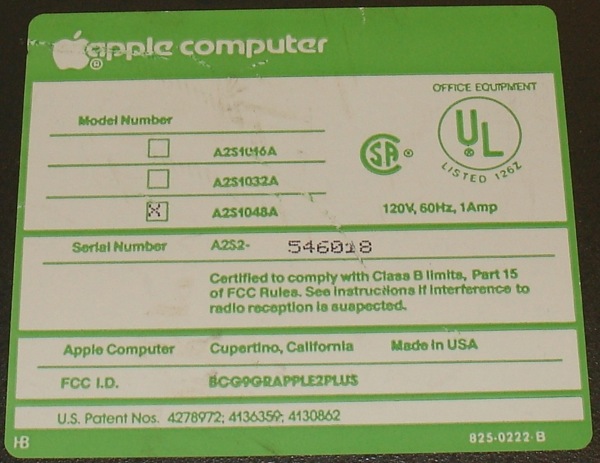
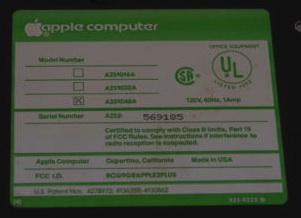
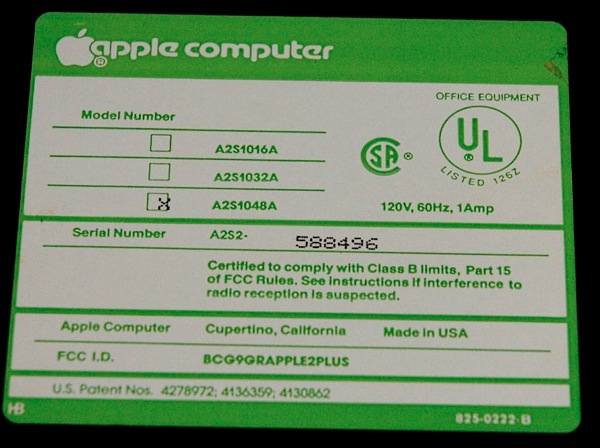
Here are my own newer two Apple ][+es as well, for comparison, A2S2-412783 (1782), and A2S2-542439 (4682).
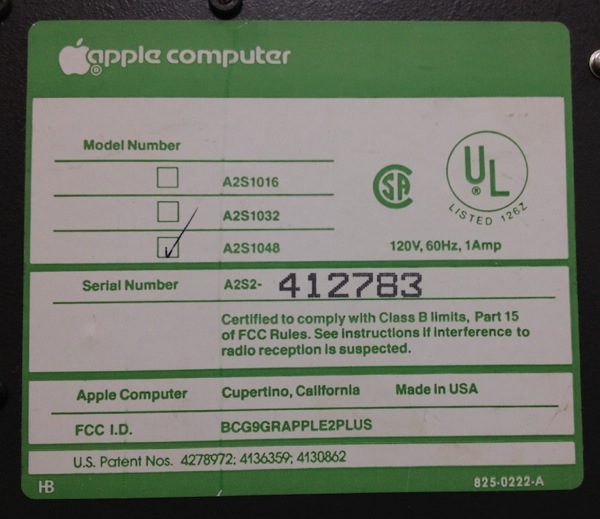
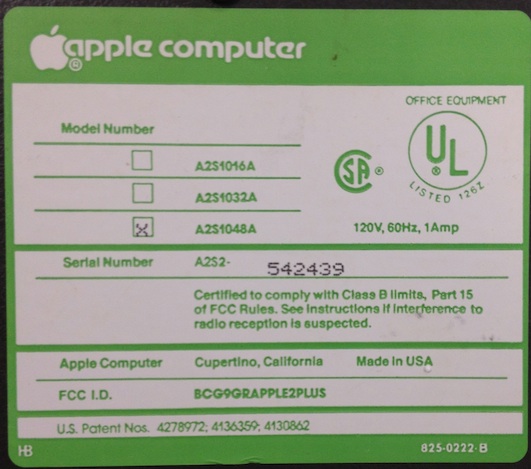
One thing I observed here is that somewhere between 512896 and 542439, the model number changed (from A2S1048 to A2S1048A). There is no reason to think that this disrupted the serial number ordering, however, just as there is no reason to think that there was any serial number reset along the whole A2S2 line. In fact, looking back I think it might even be true that the serial numbers weren't reset even between A2S1 and A2S2—both A2S1s somewhere before 61786 and A2S2s somewhere before 65001 had the older style labels, then both switched. So, since we know any what that Apple ][ and Apple ][+ co-existed for a while, I expect that the serial numbers were still unique per machine, regardless of model.
Wikipedia reports that the Apple ][ was introduced in June, 1977 and discontinued at the beginning of 1981, an estimated 40,000 having been sold. It also reports that the Apple ][+ was introduced in June, 1979, and apple2history.org reports that it was discontinued in December 1982. I can't seem to find a source for the number of Apple ][+es sold. However, the estimate of A2S1s sold is quite a bit lower than the 66077 represented in the latest serial number I've found, suggesting that A2S2s were eating up some of the serial numbers.
Next up are the Bell & Howells. They took on A2S3 as a designation. These, unlike the A2S1s and A2S2s, seem to have their own serial number stream, and had model numbers like A2S10xxB. The earliest one I've found is A2S3-001522 (no backpack). The rest are A2S3-008426 (no backpack), A2S3-011082 (backpack), A2S3-016147 (no backpack), A2S3-021075 (no backpack), A2S3-022390 (5281, no backpack), A2S3-023165 (no backpack), A2S3-031522 (backpack), A2S3-033219 (backpack). The last two are also extremely high serial numbers for a Bell & Howell, usually the estimates are of about 20,000 sold, but it looks like maybe it was over 30,000. Also interesting, perhaps, is that the Bell & Howell label for the late-style label is slightly different, redesigned to fit the late-style Apple label underneath.
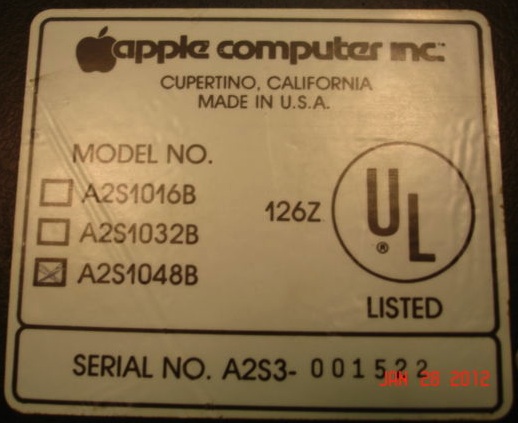
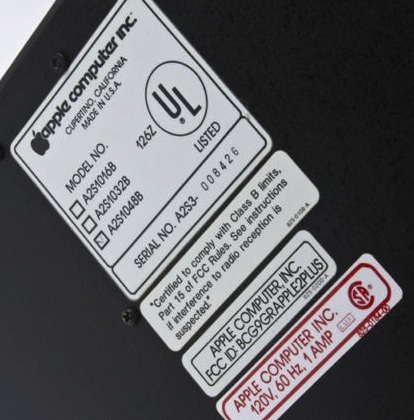
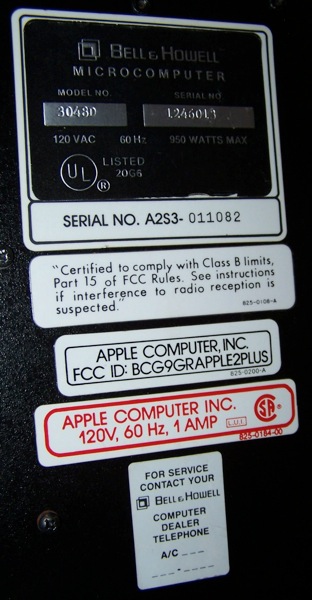
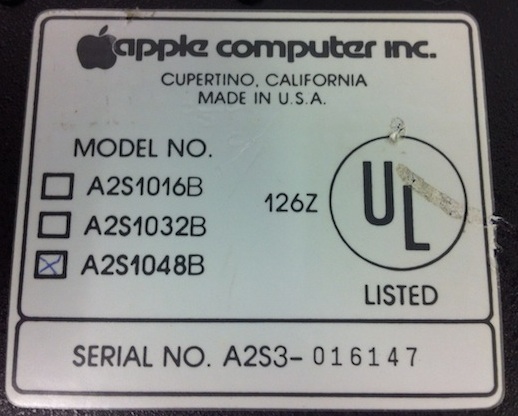
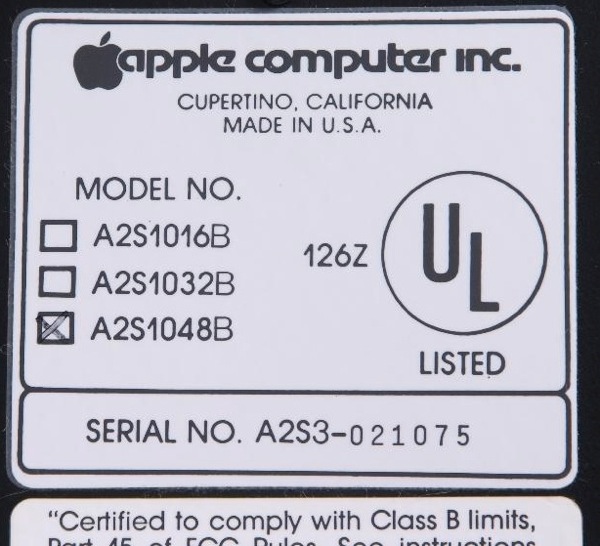
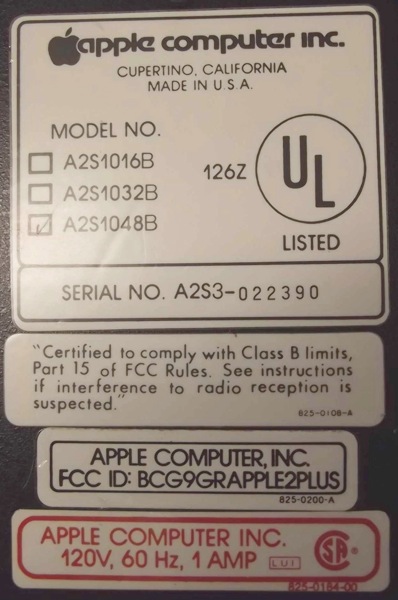
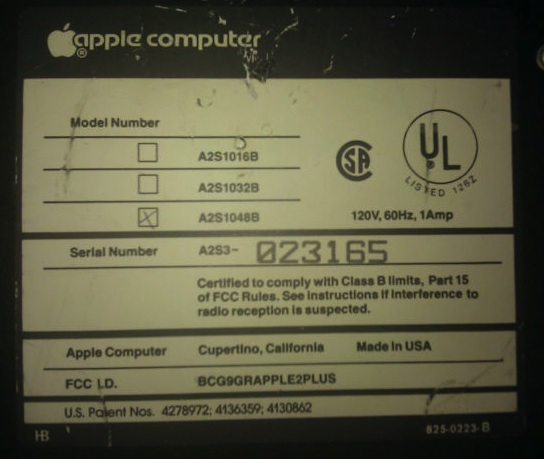
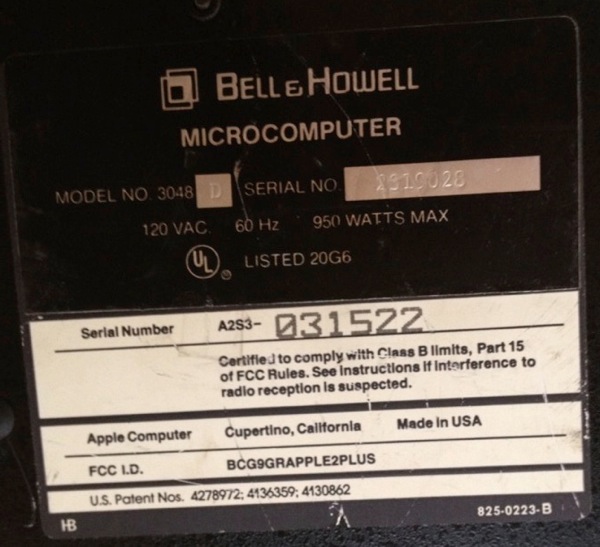
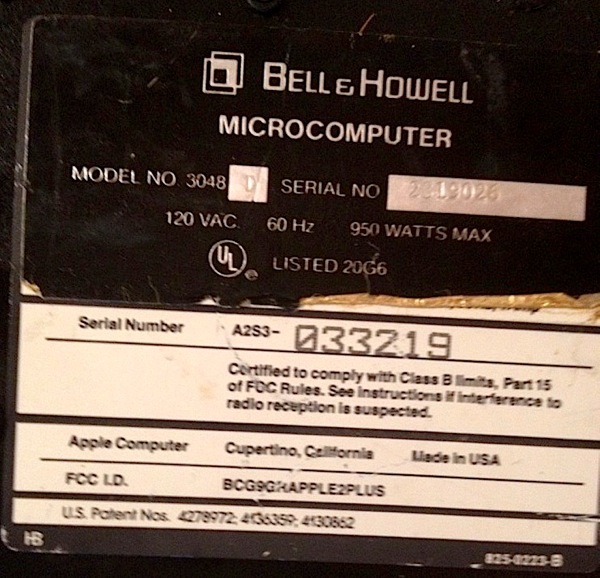
That last three are kind of interesting in that they use the last style of Apple ][+ labels. Also, it appears to me that the ones the came with the backpack (sample size above: 3) had the Bell & Howell black and silver sticker stuck overtop the Apple sticker. Perhaps this makes sense, since the backpack is what allowed the thing to be UL listed and suitable for use in schools? Anyway, the sample size increases to 4 for this generalization when I add in my own (below), A2S3-011472 (backpack). I think by now I'm relatively confident of the correlation.
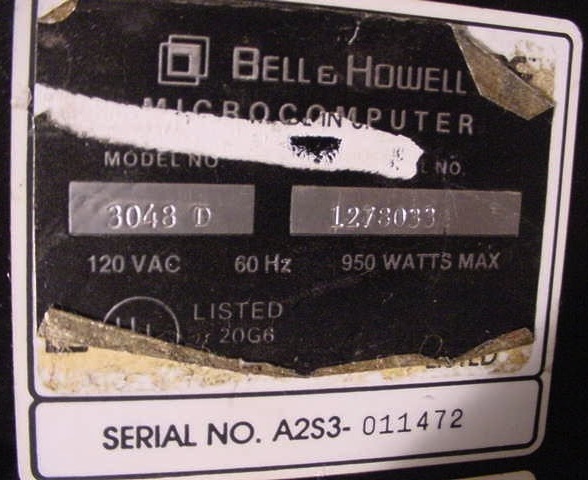
Actually, having written this much, I remembered this post from 2007, which did a similar kind of forensics. For A2S1, he has never seen a black on white sticker above 40000, or a red on white sticker below 60000. My labels conform to this, perhaps there was an actual jump to 60000. I have also not seen a green on white (bigger, simpler) sticker on an A2S2 below 65001. Perhaps 60000 to 64999(?) were printed as A2S1 and 65000(?) on were printed as A2S2? It could be, although that means that that 65001 is a pretty special machine. I've beaten his record high on A2S2 (which was 544703), though: I've got a picture of 546018 (4782). I have a picture of two that are even higher, 569185 and 588496, both of which were on an empty cases. Which I'm now suspecting were never used in building a machine, production having shut down first. My terrarium motherboard is rev 4, I'm pretty sure, which doesn't match his specs (my terrarium board is 8050, he'd capped rev 4 at 8030).
All of this brings me back to my oldest ][+, the terrarium, however. Which is the real reason I got into this: What in the world is going on with this label? A2S2-1497165 (8050)?
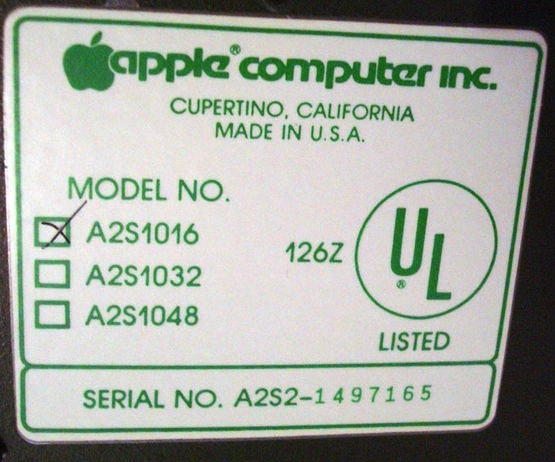
That sounds crazy. The sticker style and board date and the old-style board should have put this somewhere around 65000-149000. We know 65001 (8006) printed ok, and the next serial-board pairing I have is 149143 (8102), which is in the neighborhood of 1750 machines/week assuming no variation, so perhaps it should be around 142000 (as long as it is assumed that 66915, 93277, and 115091 had their motherboards replaced, since those were all RFI boards). So was this supposed to be A2S2-147165 and an extra "9" got in there?
Later note: The serial number on the box of the Apple ][+ listed at vintage-computer.com (1492548) is a similarly crazy one, so my machine might not be the only one. No picture of the actual label or the motherboard to allow me to compare it, though.
I don't think there's going to be any way to tell, without hearing a story from someone who saw this glitch happen, if that's what it was.